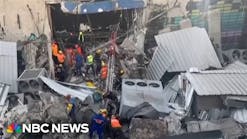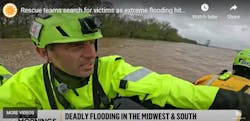The use of search lines (or lifelines) on the fireground is not by any means a new concept. Some departments have been training their firefighters to use various types of search lines for better than 20 years. Unfortunately, few to my knowledge have addressed the complexity of search line survival training. Search techniques, search patterns and deployment methods are all necessary, but user confidence and the ability to identify and navigate potential hazards during search line operations is of extreme importance for the safety and survival of our members.
Photo Courtesy Timothy E. Sendelbach
As we look at search line operations, the complexity of the search techniques and search line deployment only begin to touch the surface of what is necessary to conduct a search line operation. Issues of incident management, fireground accountability/tracking (personnel accountability reports), communications (progress reporting, "emergency traffic" procedures), proper use of PASS alarms, confidence in SCBA operations (partial and full-escape procedures), hand tool usage for navigation and probing all become an intrigue part of search line survival training.
This program has been designed as a multi-faceted training program that incorporates some of the most common fireground hazards into a realistic training scenario beneficial to all ranks. This program will not only provide participants with the necessary survival skills for safe and effective search line operations, it will also enhance some of the most basic skills of effective fireground management.
PRESENTATION:
In August of 2000, Anthony Avillo and Mike Nasta, wrote an article for Fire Engineering Magazine titled "Lessons Learned From Mask Confidence Training." This article features a mask confidence course that requires the participants to overcome some of the most common hazards found on the fireground today, hazards such as; holes in floors, open floor joist assemblies, entanglements, restricted openings were all addressed. As I read this article, I decided to take advantage of the ideas and concepts presented, while at the same time add some additional aspects that would enlist the skills necessary for search line survival training. The following information is a brief overview of what was developed.
PURPOSE OF SEARCH LINE OPERATIONS
The purpose of a search line operation is two-fold, first, search line operations are oftentimes deployed during large area operations including; supermarkets, warehouses, theaters, etc. and when a large area must be searched with a minimal number of on scene personnel. The use of search lines and/or tag lines allows a group of as few as six (6) members to cover a large area safely and effectively in a short period of time.
Secondly, search lines are deployed as a means of orientation for entering and exiting firefighters. Traditionally, firefighters are trained to orientate themselves by maintaining direct contact with walls; search lines provide a secondary means of orientation while providing firefighters additional flexibility and mobility in their search efforts.
The use of search lines during Safety Engine/RIT search operations is also becoming more common. Search lines are quickly deployed and provide a method of tracking the area searched while at the same time providing an immediate means of orientating members for rapid egress. In the case of Safety Engine/RIT search operations, search lines provide a more direct path of escape than the traditional wall orientation. This direct path also provides a quick point of directional reference for incoming rescue crews to expedite the rescue efforts.
TOOLS AND EQUIPMENT FOR SEARCH LINE OPERATIONS
Floodlight or Spotlight - A large floodlight or spotlight should be placed just inside the entrance to serve as a point of reference for rapid egress incase of disorientation. Members conducting search line operations should be trained to go towards light if they should become lost or disoriented.
Search Rope (Guideline) - The Search Rope / Guideline should be a lightweight rope (7/16 - 3/8" diameter at least 200' in length with distance and directional knotting provided every 20') carried in a durable sling style rope bag. The Guideline should be provided with snap hooks (or similar) on each end to enable the Search Leader or Safety Engine/RIT Officer (Depending on the type of operation being deployed) to quickly secure the line to a solid/stationary object just outside the hazard zone prior to initiating the search.
Consideration should be given to carrying various marking devices (such as chalk, lumber crayons, door markers, etc.) and wedges in a pouch/bag attached to the guideline rope bag to mark search areas, enhance orientation of members branching off the guideline, and to secure doorways. Additional directional marking can be provided with small portable flashing strobes placed at each change in direction (attach the portable strobe to the tie off point).
WARNING: As with any search line operations, careful consideration must be given to potential of thermal insult to guidelines and tag lines. Hose lines or high temperature search lines should be deployed where conditions for high heat or direct flame impingement exist.
Personal Tag Lines (Branch Lines) - The tag lines should be a lightweight (9mm diameter, preferably 20-30' in length with some type of captive style carabineer securely fastened to one end) rope carried in a small throw bag or similar device attached to the search crewmembers SCBA or tool belt.
CAUTION: Personal search ropes (tag lines/branch lines) should not be permanently attached to your SCBA or any part of the personal protective ensemble incase you become entangled - a quick release hook or breakaway Velcro connection should be considered.
Hand tools - Members conducting a search line operation should always carry some type of hand tool to assist in the search operation. The most notable tools to be carried are a Halligan, axe, short pike pole or closet hook. It is strongly recommended that the control member (stationary at the guideline) carry the Halligan tool while all other search crewmembers should carry an axe, short pike pole or similar tool for probing, reaching, etc.
Portable Radios - If possible, each crewmember should carry a radio with a designated frequency/TAC channel for search line/Safety Engine/RIT search operations ONLY. Search line operations are very much dependent on effective communications, failure to use a separate frequency may cause critical information to be missed thereby jeopardizing the safety of operating personnel.
Air Supply - Additional SCBA cylinders should be readily available immediately outside the hazard/hot zone (preferably 45-60 minute capacity). Longer duration cylinders will enable crews to penetrate deeper into the building while at the same time conduct a more in-depth search operation.
METHODS OF ORIENTATION
Knot Systems - Firefighter orientation is one of the most complex problems faced by the modern firefighter as he/she enters a smoke filled environment. The use of a "universal" knot system allows firefighters to identify specifically where they are and the direction of travel necessary to penetrate into the structure or exit immediately if necessary. The important point to remember with any type of knot system is that all members of your department and surrounding departments must understand it and be properly trained in it's use.
- Depth Orientation - The system used in this training program uses a 20' per knot increment ruling. Each knot located on the "entry" side of the attachment ring signifies 20' feet. Two knots would signify 40', three knots 60' and so on.
- Directional Orientation - The attachment ring is used basically as a point of reference (can also be used for branch searches if necessary), once the ring is located the firefighter quickly slides his/her gloved hand up or down the line looking for directional knots, if no knots are felt, this signifies the direction of the exit, if a knot is felt after sliding his/her hand down the guide rope, this signifies penetration into the building (the number of knots will indicate the depth into the building i.e. 4 knots = 80').
Search Patterns - Another common technique that can assist a firefighter in maintaining his/her orientation when using search lines is the use of standardized search techniques. The 12 O'clock starting position provides multiple points of reference when conducting a circular/360? degree search pattern. Anytime a firefighter attaches his/her tagline/branch line to the guideline for a circular search, he/she should be instructed to begin the search at the 12 O'clock position (The 12 O'clock position is the full extension of the search members tagline/branch line directly in line with the guideline - See below). By starting at the 12 O'clock position the firefighter is immediately oriented in his/her search effort, while at the same time he/she has a built in progress report marker at 6 O'clock ("Knot No. 4 to command, I've completed the left side search of Knot No. 4, I'm proceeding to the right side to complete my search of Knot No.4").
Building Geography - Like any search effort, firefighters should attempt to identify items in the immediate area to help provide points of reference. Items such as furnishings, floor coverings, windows, and related building features provide a good method of orientation when using search lines. Firefighters should train on providing progress reports that include geographical references; this training will lead to better orientation skills for the firefighter and better overall accountability on the fireground for the incident commander.
Oriented/Control Member - Although one of the advantages of tagline/branch line search operations is that it's somewhat an independent or a remote search operation that reduces the number of personnel needed to search a particular area, the buddy system is still a must. The use of a control member or oriented member enables firefighters to do remote, independent search operations while a second member stands by at the guideline/search line to assist with orientation, accountability and progress reporting.
Photo Courtesy Timothy E. Sendelbach
ACCOUNTABILITY / TRACKING SYSTEM
The proper tracking and accountability of operating personnel is of extreme importance when deploying search line operations. Fireground commanders must track the entry time of each participant (and establish a recommended time of exit - i.e. 15 minute work cycles), starting air supply pressure, number of personnel per crew and their location within the structure as an absolute minimum.
Time of entry/recommended time of exit - The time of entry is simply tracked by having crews notify the incident commander prior to entering the structure. The incident commander would then document the time on his/her accountability board and establish a recommended time of exit. A good rule of thumb is to use 15 minutes intervals for accountability and exit times when using cylinders rated at 30 minutes. Example: A crew enters at 13:15; their recommended time for a personnel accountability report (PAR) would be 13:30. At the same time, the incident commander would request an air supply reading and if necessary request the crew to exit. If the crew is unable to provide an air supply reading due to a lack of visibility, the crew shall be directed to exit as a measure of safety.
Starting air supply pressure - Documenting the starting air supply pressure enables the incident commander to establish a recommended exit time and/or work cycle. Although it should not be a common practice, some members may enter a structure with less than full cylinders, if this is the case, the incident commander should make the necessary notations and adjust his/her recommended exit time/work cycle accordingly. As previously stated, anytime a PAR report is requested, the incident commander should also attempt to obtain an air supply reading from the operating crews. If at anytime an accurate reading cannot be obtained the incident commander should direct crews to exit as a means of safety.
Search crew location - The search crew location should be accurately tracked based on progress reports and assignments given. The initial assignment may be to search Knot No. 4 (last known location should be reflected on the accountability board), once a progress report is provided, the incident commander should then update the accountability board to reflect the latest report (i.e. Team 3 to command, we've completed the search on Knot No. 4, proceeding to Knot No. 5). Although this course does not required the participants to perform specific search operations, the knots should be used as a means of tracking the participant's location within the structure.
Area searched/area to be searched - Another technique for proper tracking and accountability is to have the incident commander provide a detailed sketch of the search operation. By drawing a sketch of the search area, the incident commander can provide visual instructions to crews as they are deployed into the structure. Furthermore, by requiring the incident commander to use a tactical worksheet we again reinforce the use of another vital tool that is oftentimes underutilized on the fireground.
COMMUNICATIONS
Pre-established communications policies and procedures/guidelines should be reviewed and reinforced throughout this training process. The use of "Emergency Traffic" request should be used throughout this and other training programs to reinforce personnel confidence and familiarity with the required steps and procedures to follow during emergent fireground situations.
The importance of correct terminology, tactical channel usage, progress reporting, and personnel accountability reports cannot be overemphasized. No incident commander regardless of his/her experience level or expertise can effectively manage an incident without an occasional progress report. Take the time to discipline yourself and your crew to provide the incident commander with the necessary information to ensure your safety and survivability. Communication is absolutely essential. "Practice like your life depends on it, because it does!"
Related:








